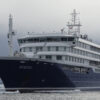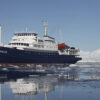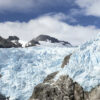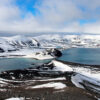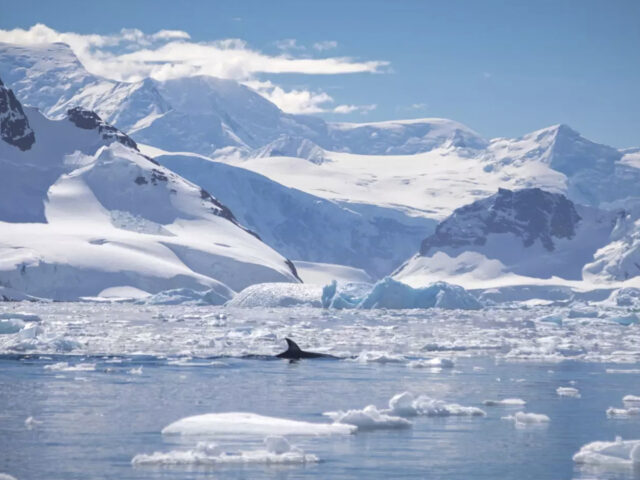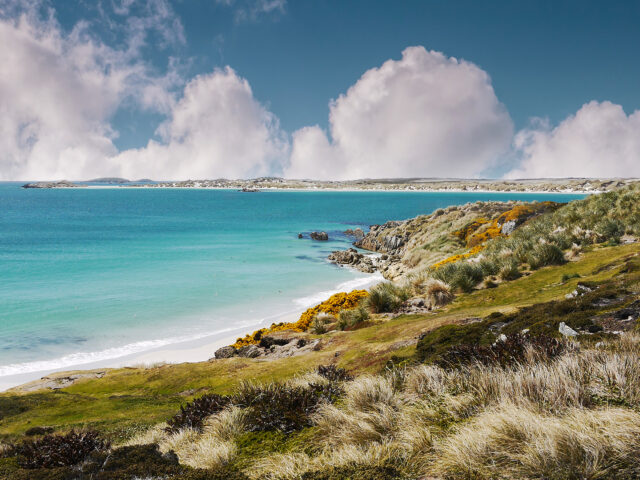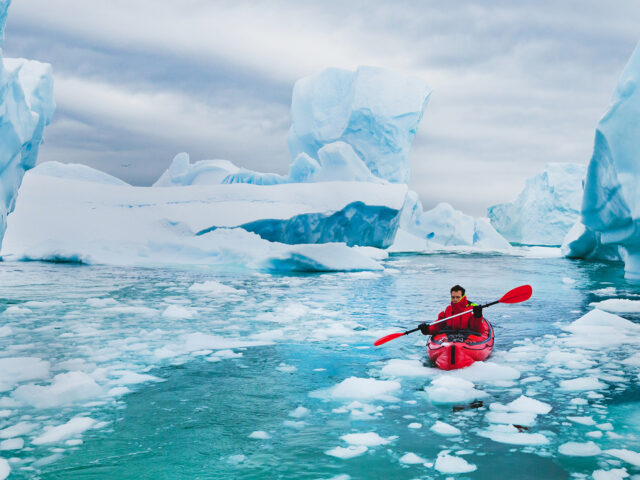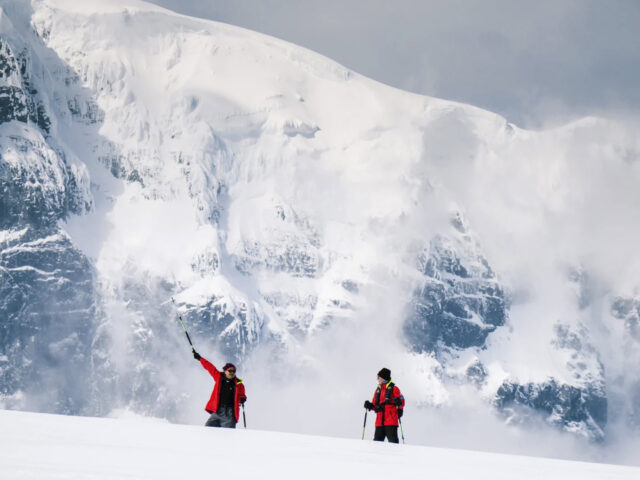Highlights
This Antarctic Peninsula and South Shetland Islands cruise delivers you into a landscape of dark rugged rock, pure white snow, and a fantastic variety of wildlife. Come say hello to whales, seals, and thousands of penguins.
Ships
Standard Activities
About the Antarctica - Discovery & Learning Voyage
This Antarctic Peninsula and South Shetland Islands cruise delivers you into a landscape of dark rugged rock, pure white snow, and a fantastic variety of wildlife. Come say hello to whales, seals, and thousands of penguins.
Itinerary Day to Day
End of the world, start of a journey
Your voyage begins where the world drops off. Ushuaia, Argentina, reputed to be the southernmost city on the planet, is located on the far southern tip of South America. Starting in the afternoon, you embark from this small resort town on Tierra del Fuego, nicknamed “The End of the World,” and sail the mountain-fringed Beagle Channel for the remainder of the evening.
Path of the polar explorers
Enter the Antarctic
Scenes of South Shetland
Familiar seas, familiar friends
There and back again
Route Map
For those craving a truly immersive polar adventure, our open-air camping activity gives you the chance to experience the Antarctic wilderness as few travelers have.
We provide the necessary camping gear, including breathable bivouac bags that are wind and waterproof and a lightweight alternative to tents. And our polar sleeping bags will keep you warm, dry, and comfortable during the enchanting Antarctic night.
All campers will be assisted and supervised by experienced expedition guides.
General information on our camping activity
Camping is available based on weather, site conditions, and environmental regulations.
Everyone can participate, no previous experience required.
The maximum number of participants is limited to 30 per night.
All camping activities are supervised by expert field guides.
Basic equipment is provided by OEX (bivouac bags, mats, boots).
One camp night must be booked prior to your trip, but extra nights may be arranged on board (no waitlist). Please contact us for details.
Details of the Antarctic camping experience
We aim for at least one night of camping on each designated trip, but the expedition team will offer more if possible. Additional nights are determined by weather and local conditions and can only be offered when it is a possible for the vessel to stay close to shore. If the vessel has to relocate during the night, camping is not possible.
According to Antarctic Treaty and IAATO regulations, we are not allowed to take stoves, fuel, or food on shore with the exception of emergency rations, survival gear, water, and medical supplies.
The camping group will be taken to shore after dinner, and then returned to the ship before breakfast. Our camps will always be made in a place where wildlife will not be disturbed.
All campers will be equipped with a personal waterproof bag containing a sleeping mattress, synthetic sleeping bag with inner liner, and a breathable bivouac bag. Besides these personal items, other gear will also be taken to shore.
While campers are on shore, our staff will be in full radio contact with the ship at all times. Guides will also stay on shore to assist and supervise the campers. Upon departure, the campsite must be cleaned and everything returned to the ship.
Clothes to bring for camping
Please pack for the worst weather, as conditions in Antarctica can change rapidly. Below is a list of important items you must bring yourself:
- Thermal underwear, fleece vest or jacket, and down jacket that is breathable (e.g., Gore-Tex)
- Warm hat and turtleneck or neck gaiter
- Thermal under-gloves, fleece finger gloves, or warm mittens
- Thick socks with spares
- Good UV-protectant sunglasses
- Sun cream or sunblock
- Flashlight or lightweight headlamp for departures in February – March
Gear we provide for camping
- Insulated waterproof rubber boots
- Bivouac bag (one per person) and mattress
- Waterproof sleeping bag with cotton inner liner
- Portable field toilet (one per group)
Special note: Cotton clothing, such as normal T-shirts and jeans, are not advisable. Cotton tends to get wet and stay wet while moving in a cold environment. We recommend thermal underwear.
Weather conditions
Exploring remote and wild regions like Antarctica requires a sensible and flexible approach. Although there can be clear skies with bright sunshine, the weather is unpredictable. Katabatic winds caused by the icecaps and glaciers can pick up suddenly and are a fierce opponent for polar travelers. Such conditions might also lead to the cancelation of planned camp nights. If local circumstances prevent us from camping on shore, we may attempt to camp on the open decks of the ship.
In order for the camping activity to take place, we must have at least 10 passengers who intend to camp. Only 30 passengers can camp at any one time, and we always assign one expedition guide per every 20 campers to assist and supervise operations.
Lastly, we do not use tents as part of our camping equipment. Tents are greatly affected by wind in Antarctica, and using them greatly reduces the weather in which we can camp.
Instead, we have found that bivouac sleeping bags offer us the best odds of being able to follow through with our camping activity. They also provide an unparalleled experience by allowing you to see and hear all that is happening around you, from the noise of penguin calls to the sound of whale blows. They also offer the best view of the beautiful Antarctic skies.
Camping FAQ
Is it possible to take food?
Eating food and snacks on shore is not allowed, per the Antarctic Treaty and IAATO regulations, in order to prevent the spread of outside plants or contaminants.
Can I go to the toilet?
Toilet visits should be avoided on land, per the Antarctic Treaty and IAATO regulations. Campers are encouraged to instead use toilet facilities on board prior to camping. A portable toilet will be available on shore, however, and all solid waste must be returned to the ship. It is advisable that campers bring a “pee bottle” (e.g., wide-opening Nalgene bottle) for their comfort.
Where and how long do we stay on shore?
We offer near-shore camping on the continent and / or nearby islands depending on the itinerary, weather, and regulations. Camping groups stay a maximum of 10 hours on shore.
What if local weather and ice conditions are unsafe for camping?
The expedition leader will do their best to ensure the camping activity takes place. But if local circumstances prevent us from camping on shore, we may attempt to camp on the open decks of the ship.
Is prior experience required?
Everyone can participate in this activity without previous experience. There are no physical requirements except helping the guides put up and clean the campsite. Please note, however, that we are not camping in a campground: There can be rocks, snow, mud, and frozen surfaces. We expect our campers to help prepare the campsite and break camp the next morning. All equipment must be cleaned thoroughly after use. The weather can sometimes make these tasks difficult.
What are the weather conditions?
Around the coasts of Antarctica, temperatures are generally close to freezing in the summer (December – February) or slightly above freezing in the northern part of the Antarctic Peninsula. The temperatures in Antarctica vary between about -5 to 8°C (23 to 46°F). In strong wind, these temperatures can feel sub-zero. Warm clothing, a flexible attitude, and a sense of adventure are the best ways to overcome these sometimes-harsh conditions.
***Only available in Plancius
One of the best things about a polar voyage is that you’re never done exploring. Even if you think you have walked every shore, climbed every mountain, and spotted every penguin (or polar bear), there is still a whole other world to explore on the water.
Polar kayaking is a great way to tour the blue-and-white beauty of the polar seas up close, visiting stunning ice formations and waterways too small for our ships to enter.
Do I need to be an experienced kayaker?
The amount of experience we require depends on the cruise you choose. If you have no experience at all, we suggest one of our Basecamp voyages, where we will happily introduce even the most inexperienced kayakers to this wonderful outdoor sport.
The toughest part of kayaking in gentle waters is usually getting into the kayak itself. After that, you just have to keep a steady rhythm with your paddles.
Some of our cruises require that you have more kayaking experience because they involve longer kayak excursions. These excursions expose you to water that might not be as gentle as a sheltered bay, and you stand more of a chance of encountering rougher weather conditions.
You will not need to be able to do a kayak roll, but you should be able to demonstrate that you’re comfortable in a sea kayak. On these non-Basecamp excursions, our guides reserve the right to refuse you access to a kayak if it is clear you don’t have the necessary experience. This is for your safety as well as theirs.
How physically fit do I need to be?
You will want to be in decent physical shape and possess a good sense of balance. Kayaking can be demanding on your core and arm muscles.
Is polar kayaking safe?
All of our kayaking outings are led by certified and experienced guides, but you must always take caution when kayaking in the polar regions.
We will provide you with suitable outer clothing for kayaking. Kayak excursions are limited to 14 passengers per kayak guide. This number lets our guides keep track of everyone and make sure our guests are having a good time.
One guide stays with the group in a support kayak, while a safety boat follows in case of emergencies. All guides will try to scale excursions to the skill level of the group.
Do I have to bring my own kayaking equipment?
We will provide the following items:
- Seven double-seat sea kayaks on Plancius & Ortelius
- 14 double-seat sea kayaks on Hondius & Janssonius
- Paddles with anti-drip rings
- Basic (4 mm neoprene) wetsuits in different sizes
- Kayak spray cover
- Waterproof lightweight jacket (cagoule)
- Life jacket / kayak vest
- Neoprene boots
Please bring the following gear:
- thermal underwear, bottom and top (for under the wetsuit)
- fleece jacket or vest to wear over your thermal underwear
- gloves (insulated ski or snowboard gloves with grip or neoprene watersport gloves)
- waterproof bag (if you are bringing a camera or binoculars)
- fleece hat
- turtleneck or neck gaiter
- thick socks
- sunglasses
- sunblock
Avoid bringing cloth clothing like T-shirts or jeans. Once it gets wet (from water or sweat), it will stay wet for a long time – not a comfortable experience in polar weather!
What will I see while kayaking?
You’ll see rugged shorelines sloping up into snow-capped mountains, pristine beaches, and icebergs that turn the water beneath you a brilliant blue. You may also see some local wildlife, which the peaceful nature of kayaking makes even better.
***Only available in Plancius
Antarctica’s dazzling icecaps, colossal glaciers, and towering mountains are rivaled only by the white-sand beaches and lush flora of the sub-Antarctic islands. Both areas host a large variety of penguins, whales, seals, and seabirds.
During these dives, you may observe penguins, fur seals, and perhaps even leopard seals. Many of the sub-Antarctic islands are also rich with krill, one of the prime food sources for many marine species and therefore highly useful in locating wildlife.
General information on our diving activity
- Divers must be experienced with cold-water, dry-suit diving.
- We aim for one to two dives per day (one in the morning, one in the afternoon).
- Our ability to dive depends on local ice and weather conditions.
- All dive guides are certified and experienced experts in their field.
- We offer basic equipment on board (e.g., tanks, compressors, and weights), but divers must bring their own personal gear.
- We make dives from our Zodiac boats.
- Our maximum dive depth is around 20 meters / 65 feet.
- We may observe sea squirts, squat lobsters, spider crabs, soft corals, anemones, peacock worms, dogfish, sea snails, crabs, sea butterflies, shrubby horsetails, jellyfish, sea hedgehogs, kelp walls, and several species of starfish.
- Please contact us for details on booking this activity
Weather in the polar regions
In Antarctica’s Southern Hemisphere summer (December to February), temperatures are generally close to freezing, varying between -5 to 8°C (23 to 46°F). Combined with the strong katabatic winds of this area, the cold can often feel even colder.
Warm and waterproof clothing (and a flexible attitude) is required for Antarctica. Severe weather may lead to the cancellation of landings and dives, as excursions can only take place in safe conditions.
Program changes due to weather and ice
We know our dive destinations in great detail and are always exploring new sites, but every dive can encounter surprises. It is important to remember that nature calls the shots in the polar regions. Personal expectations that are not met are not grounds for reimbursement.
Please note that our itinerary is always subject to safe local conditions. It is always possible that ice, weather, or wildlife will force us to change our sailing schedule. It is also possible that certain bays or fjords will be closed because of ice.
In such cases, we always have planned alternatives. But again, these alternatives are not grounds for reimbursement. When changing the itinerary, we assure you that the captain, expedition leader, and dive leader will do their utmost to provide you an equally good replacement program.
Dive experience and qualifications
Our polar dive voyages are not for beginners. They are meant for experienced divers who are familiar with cold-water, dry-suit diving. You must have logged at least 30 such dives to participate.
Before departure, please present an internationally accepted diving certificate and logbook. Also, we ask that you include copies when completing your diver personal information form.
The first dive of our voyage will be a “check dive” to try out your gear and assure our dive leader that you have enough experience to participate. This is for your safety and that of our guides.
If our dive leaders feel that any diver does not meet the necessary experience, they can exclude that diver from the dive program. In this event, Oceanwide Expeditions cannot be held responsible and will grant no claims for reimbursement.
All divers are required to follow the instructions of dive leaders and guides at all times. All divers are participating 100% at their own risk, which is also the case during land excursions.
Expedition team, excursions, & dive leaders
Our expedition team consists of one expedition leader and multiple guide-lecturers. All members of the team are extensively experienced in working in the polar wilderness.
Every morning after breakfast, you will be informed of the day’s program (position of the vessel, general information about the area, itinerary, and expected wildlife during the excursions). The excursions will then be evaluated in the afternoon and after dinner.
Occasionally, the expedition team will organize lectures, sometimes supported with slide shows, to inform the passengers about various features of the polar environment.
Our dive leaders are highly experienced instructors assisted by one or two dive guides. The main language of all guides and dive operations is English unless otherwise stated.
Special note: Safety first
Diving in the remote polar regions is no more dangerous than normal scuba diving as long as you follow one important rule: safety first.
All divers looking for dangerous stunts or deep dives are asked to refrain from this activity. There are no decompression chambers in Antarctica or the Arctic, medical care is almost non-existent, and there is hardly any infrastructure. Although we have a doctor on board the vessel for first-aid assistance, we cannot accept risky ventures from any divers.
DIVE PROCEDURES
Approach to dive site
In normal circumstances, the number of divers per Zodiac is six passengers as well as one driver-guide. Always watch your valuable gear when embarking and disembarking the Zodiacs. We are not liable for the loss of individual equipment.
The voyage starts with a check dive so that all divers can get used to the cold water, try out their equipment, and determine the weights they need. Before each dive, there will be a briefing about the dive site, weather and ice conditions, and the procedure of the dive.
Currents
Water currents can be present anywhere and at any time. The dive guides will select a dive spot that is safe and also give information about returning to the Zodiacs if needed. Normally there is very little current where we dive, if any.
Dive buddy
Dives will be made using the buddy system. The dive guide will not be in the water to accompany and lead divers. Rather, dive guides stay on the surface for the divers’ safety. Divers are expected to be experienced enough to read their compasses and depth gauges and look after each other. Buddy teams are important, so we let our divers match themselves as much as possible. In cases where divers have not paired up or are in doubt, dive guides sit with divers to discuss their expectations and experience. We try to pair people of similar interests and experience. If there is an uneven number of divers and three-person groups are not feasible, dive guides will accompany divers.
Dive guide-to-diver ratio
Our programs allow for six divers per dive guide, with a preferred maximum of 24 diving passengers per voyage. Groups larger than 24 will need to split dive activities, and we also may reduce the number of dives so that we can safely manage activities.
Drifting pack ice
This is a real hazard. If pack ice approaches while divers are underwater, it can be hard to see people if they surface in the middle of it. For this reason, it is important to only dive around icebergs that are hard aground or floating in water clear of brash or pack ice. Many of the dive sites have slopes or faces that go deeper than the 20 meters (65 feet) maximum limit for our dives. Divers must act responsibly and show self-discipline.
Equipment
Once you have settled into your cabin, you will be given an area to store and hang your equipment. Every diver is expected to prepare their own equipment in advance of each dive. Bring your own spare parts for regulators and dry suits in case of leaks or damage. Divers are expected to set up and carry their own equipment in and out of the Zodiac as well as up and down the gangway.
Number of dives
We plan for one to two dives per day, but an exact number of dives cannot be given due to the possibility of variable ice and weather conditions.
Visibility
Ample pack ice often means flat water with clear visibility. Little pack ice can mean plankton blooms, because there is more daylight and possibility of swells. But the ice and weather conditions are different every year, so there is no way to predict them.
DIVE EQUIPMENT
Please bring the following equipment yourself:
- Dry suit with hood
- Two sets of warm underwater garments
- Dry gloves or wet gloves/mitts adequate for sub-zero waters
- Two freeze-protected regulators. (We dive with special bottles that have two separate outlets, and we use 12L steel tanks fitted with a Y or H valve configuration and DIN or Yoke (INT) adaptable connections.)
- Stabilizing jacket or BC with quick-release capability and sufficient lift capacity
- Pressure gauge
- Compass watch
- Knife and torch
- Mask, fins, and snorkel
Dry suits
These are the only adequate protection in Arctic and Antarctic waters, which can be as cold as –1°C (30°F). The type of dry suit you use is not important so long as it fits you, is waterproof, and you are comfortable using it.
Neoprene dry suits have the benefit of good stretch and extra insulation. Shell suits provide no extra insulation but are lighter and dry quicker. They serve only to keep you dry and require extra layers of garments under the suit. If possible, bring a small dry suit repair kit.
Dry suit accessories
If a hood is not attached to your dry suit, you will need to bring one. A 7mm neoprene hood with face and neck seal is recommended.
Regular 7mm neoprene semi-dry gloves or mitts may also be used with any dry suit and are relatively easy to use. Three-finger mitts are warmer than five-finger gloves. You can also use special dry gloves that seal against rings on the arm of the dry suit.
To prevent glove squeeze and promote warmth, short pieces of surgical tubing or straws can be inserted under your wrist seals to allow air exchange between your suit and gloves. This type of glove requires additional practice, as they can fall off if not used correctly.
Face masks
We recommend a standard mask, but the type of mask you use is not critical. You may use a full-face mask if you are experienced with them. Commercial defogging agents work well for polar diving.
Please keep an extra face mask handy in case your regulator free flows. Straps can also become brittle in cold weather, so we highly recommend bringing a spare strap and mask.
Insulating undergarments
The colder the water, the more (and thicker) layers of undergarments are required. We recommend you wear two or three layers, depending on your suit.
As the first layer, you should wear a set of polypropylene liners. This material helps absorb moisture from the body. As the second layer, wear thick insulating material like fleece, synthetic pile, Thinsulate, or similar. As the final outer layer, we suggest a windproof shell.
The one-piece jumpsuit style is the most common and comfortable configuration of dive wear. It is available in a variety of thicknesses, depending on your dry suit and the water temperature.
Post-dive clothing
It is important to bring a warm hat and warm waterproof gloves to wear before, and especially after, your dives.
Regulators
Normal regulators will not function where we dive, since both the first and second stage could freeze. You are therefore required to bring two sets of regulators (first and second stage) suitable for cold-water diving.
***Only available in Plancius
What's Included
-
Voyage aboard the indicated vessel as indicated in the itinerary
-
All meals throughout the voyage aboard the ship including snacks, coffee and tea.
-
All shore excursions and activities throughout the voyage by Zodiac.
-
Program of lectures by noted naturalists and leadership by experienced expedition staff.
-
Free use of rubber boots and snowshoes.
-
Luggage transfer from pick-up point to the vessel on the day of embarkation, in Ushuaia.
-
Pre-scheduled group transfer from the vessel to the airport in Ushuaia (directly after disembarkation).
-
All miscellaneous service taxes and port charges throughout the programme.
-
Comprehensive pre-departure material.
What's Excluded
-
Mandatory travel insurance
-
Any airfare, whether on scheduled or charter flights
-
Pre- and post- land arrangements.
-
Passport and visa expenses.
-
Government arrival and departure taxes.
-
Meals ashore.
-
Baggage, cancellation and personal insurance (which is strongly recommended).
-
Excess baggage charges and all items of a personal nature such as laundry, bar, beverage charges and telecommunication charges.
-
The customary gratuity at the end of the voyages for stewards and other service personnel aboard (guidelines will be provided).










































